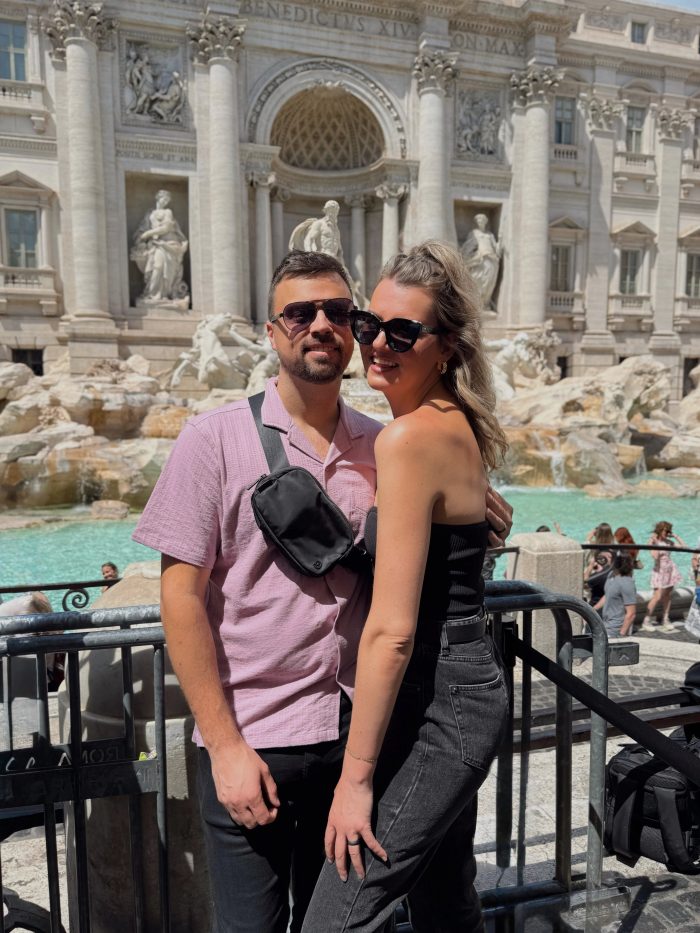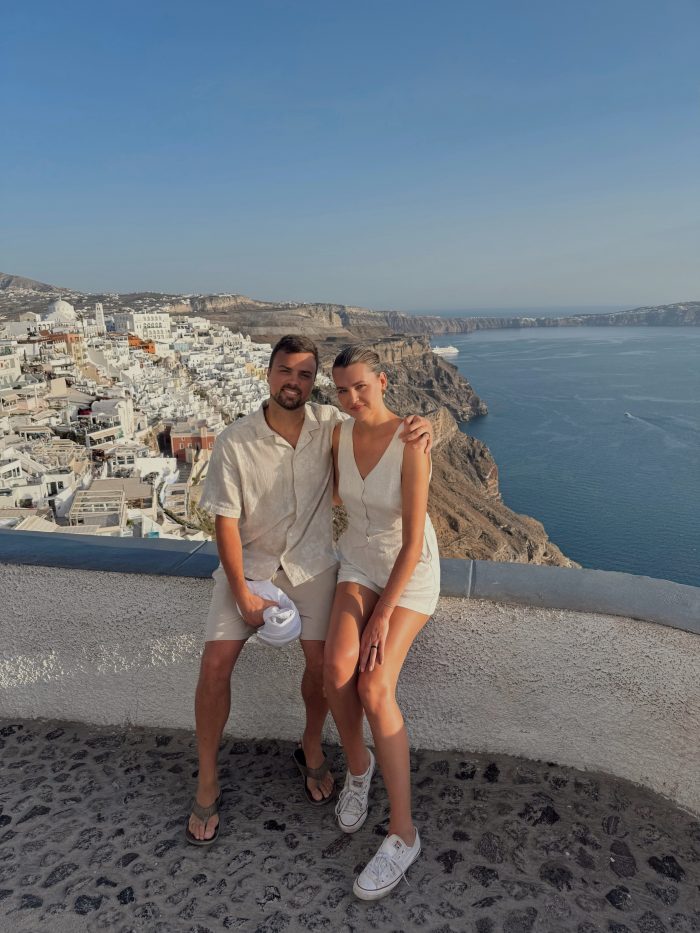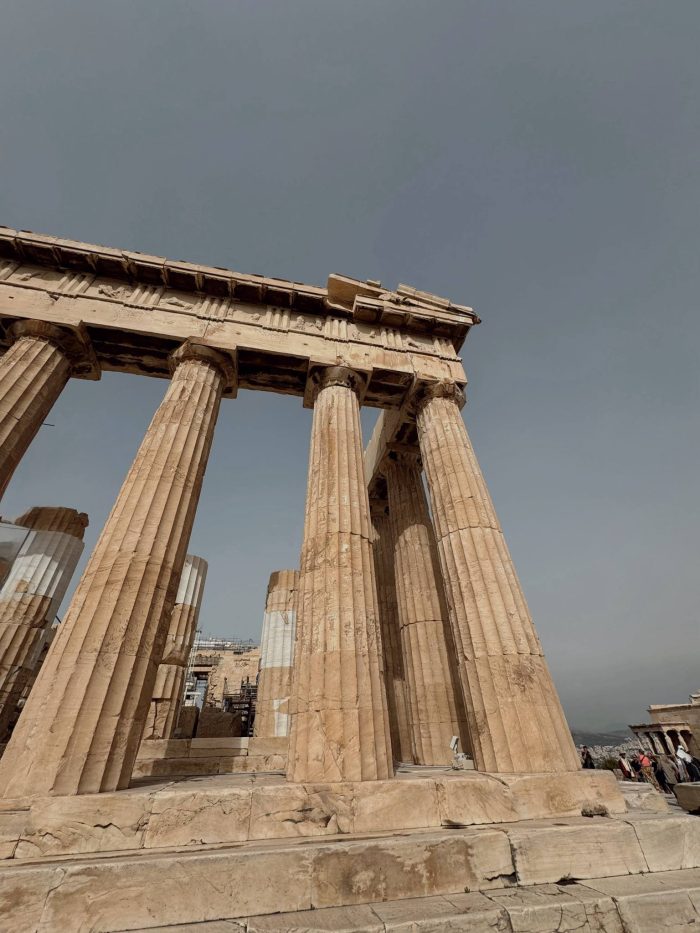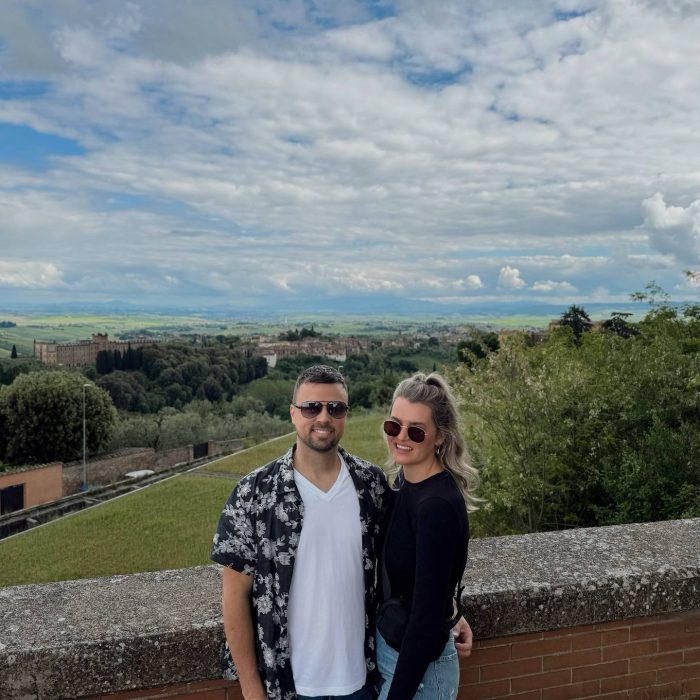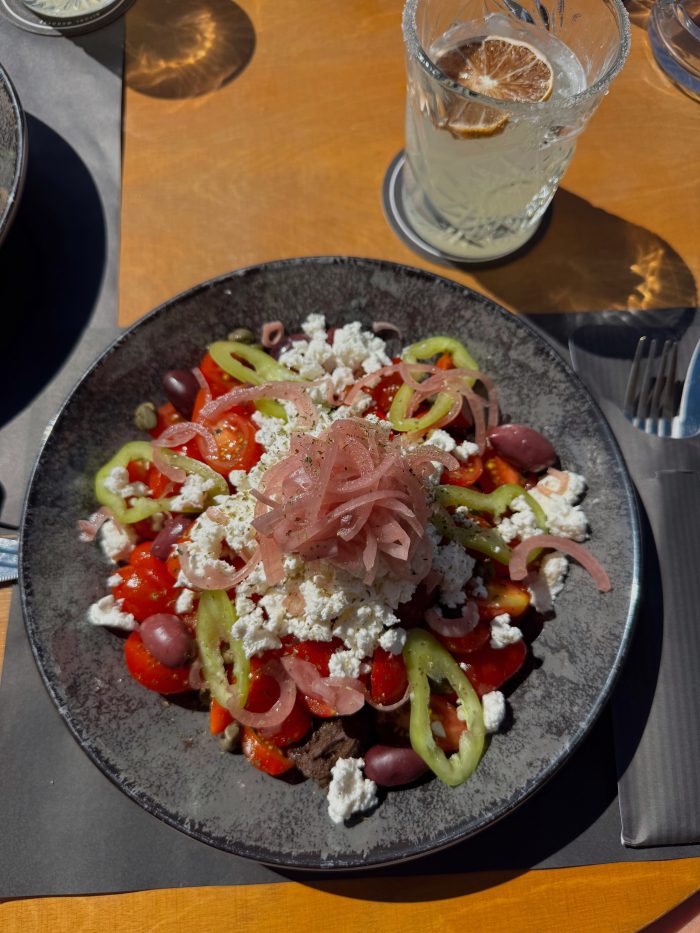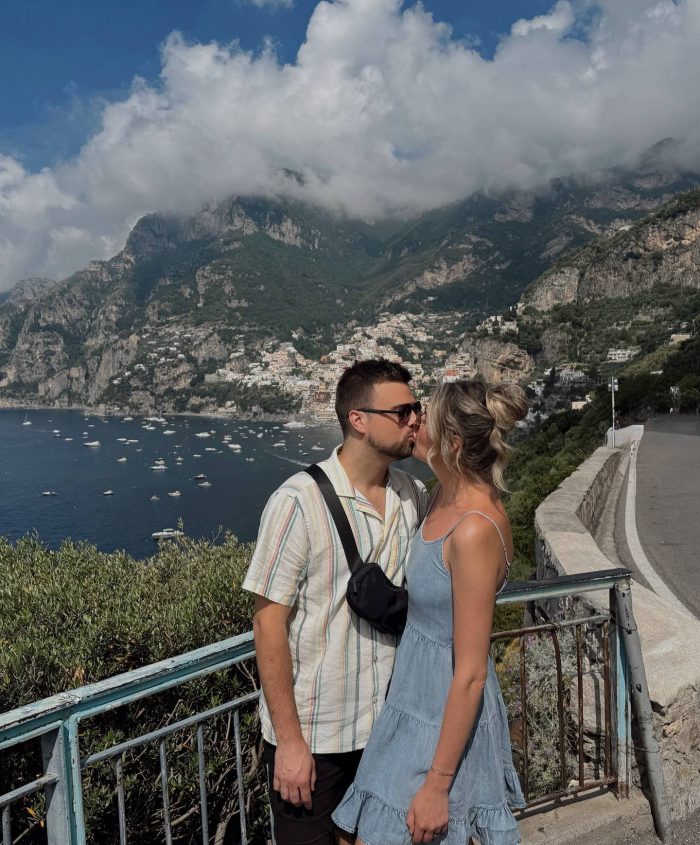Italy to Greece: Our Dream Honeymoon
After getting married in September of last year, Mason and I finally took off on our dream honeymoon, and it was everything we hoped for and more. In May 2025, we spent three incredible weeks exploring some of the most romantic and historic places in Italy and Greece.
It was the trip of a lifetime—relaxed, romantic, and full of special moments. I’m so excited to share all the highlights, favourite spots, and travel tips from each destination we visited. You can view my recap reel here, along with my highlights from the trip on my Instagram. And if you missed the wedding blog, you can catch up on that here too. Let’s dive in!
Itinerary
We started in Venice (2 nights), exploring the canals and city streets. Then Siena (3 nights), nestled in Tuscany’s hills with great wine and views. Next was Rome (3 nights), packed with history and lively streets. After that, Sorrento (3 nights), a charming coastal town.
In Greece, we spent 2 nights in Athens, rich with ancient sites. Then off to the islands: Naxos (4 nights), a relaxed spot we loved, and Santorini (2 nights), famous for its stunning sunsets and views.
Travel Tips
Flights & Transportation:
- We flew premium economy for our long-haul flights. It was 100% worth the splurge, especially since we’re both tall. The extra space made a big difference in our comfort. We personally preferred Air Canada’s premium economy experience over Lufthansa’s.
- We booked overnight (red-eye) flights and that worked really well. We’d land in the afternoon, stay up until the evening, and then sleep. This helped us adjust to the time zone pretty quickly! Within a couple of days, we were on track.
- We used just about every form of transportation: ferries, high-speed trains, planes, buses, and taxis. Italy’s train system is super efficient and easy to use.
- Driving in Italy? Terrifying lol. We skipped it as it seemed chaotic and stressful. Between public transit and walking, we got around easily and didn’t feel like we missed out by not renting a car. That said, we did a lot of walking, so we were intentional about booking centrally located hotels, ideally close to train stations or the airport for easy access.
- Also, if you’re planning a multi-stop trip like ours, download the Rome2Rio app. It was a game changer for mapping out how to get from one place to the next.
Packing & Luggage:
- Shoes: I rotated between my white Converse and Birkenstocks for most of the trip. But if you need more support, pack a good pair of runners. As I’ve mentioned, you’ll be walking a lot, and the cobblestone + stairs are no joke.
- One of my absolute essentials was a white linen button-up — I’m not exaggerating when I say I wore it almost every day! It was the perfect lightweight layer for cooler evenings or for tossing over my swimsuit on beach days. Whether it’s a linen shirt, set, or dress, I highly recommend packing some breathable linen pieces for both comfort and versatility.
- Pack your own conditioner! None of the hotels we stayed at provided it, so having a small bottle in your toiletry bag will definitely come in handy.
- Packing cubes were a game changer for keeping our luggage organized, especially since we were moving around a lot.
- Your suitcase will take a beating. You’ll be dragging it across cobblestones, lifting it up stairs, and rolling it down uneven streets, so skip the designer luggage for this one.
- We added Apple AirTags to our suitcases for peace of mind. It was super reassuring to track our bags in real-time, especially during layovers.
- We also locked our luggage with small travel locks as a precaution.
- Don’t count on elevators—or lifts, as they’re called in Europe! Many hotels don’t have them (and if they do, they’re usually tiny), so be prepared to carry your bags up narrow staircases.
Accommodation & Hotels:
- Every hotel we stayed at had a hair dryer, but none had an iron. Our go-to hack? Turn the shower on hot and hang your clothes in the bathroom. It’s not perfect, but it did a decent job of steaming out the wrinkles!
- The hotels we stayed at use key cards to control electricity in the room. When you leave (and take the key card with you), everything powers down including your phone charger, lights, and AC—so keep that in mind if you’re hoping to charge devices while you’re out!
- Expect a city tax at each hotel, charged on top of your room rate. It varied quite a bit—some were around €3–5 per night, while others (especially in Rome) were upwards of €10+ per night. In Rome, we ended up paying around €50–60 in city tax for a three-night stay. It’s usually charged per person, per night, and collected at check-out.
- When checking into hotels in Europe, it’s completely normal to be asked for your passport information. Sometimes they’ll scan it, other times they’ll take down the details manually. This is a standard procedure for guest registration and security purposes, so don’t be caught off guard. We also found that some tours required passport details when booking or before the tour started, especially for anything involving transportation.
- Hotel breakfasts are usually included and surprisingly good! Fresh fruit, great coffee, and often made-to-order eggs.
Money & Budgeting:
- Taxis in Italy and Greece often prefer cash, so it’s a good idea to have some euros on hand. Some vendors may also try to steer you toward paying in cash, but if they have a card machine, they’re legally required to accept it—don’t be afraid to ask. We brought about €200 in cash and found that was more than enough. We paid for everything else with a credit card.
- Speaking of taxis, be cautious. Unfortunately, scams are common. To avoid surprises, we made it a habit to ask for the fare before getting in the cab. It helped us get a rough idea of what to expect and made the ride feel a lot more transparent.
- One thing that really helped us: spacing out big travel expenses in the months leading up to the trip. We booked flights one month, hotels the next, and tours after that. By the time we left, everything was already paid for, which made the trip feel a lot more stress-free. All we had to budget for was our daily spending while we were there.
- The Canadian dollar exchange rate wasn’t great, but if you looked hard enough, you can still find affordable meals—pizza or pasta for around €9 and a great coffee for €2.50 in many spots.
- All in all, it was definitely an expensive trip—but with some planning, it was totally manageable!
Safety & Convenience:
- My Lululemon belt bag was a lifesaver. I wore it crossbody every day—it kept my essentials close and secure, especially in busy areas.
- We were constantly warned about pickpockets (especially in busy places like Rome and around major train stations like Napoli Centrale), but we didn’t have any issues. That said, it’s always smart to stay alert. Keep your valuables tucked away, avoid leaving bags unattended, and be extra aware in crowded spots.
- To play it safe, we left our passports in the hotel safe and brought only what we needed each day. We also wore our travel rings and left any expensive jewelry and valuables at home.
- A small essentials kit also came in handy. Things like Band-Aids, Advil, Vitamin C, or any personal must-haves you won’t want to search for abroad.
- Don’t forget a travel adapter! Europe uses different plugs, and we noticed most outlets in Greece were 2-prong, while some in Italy needed 3-prong. A universal adapter is definitely worth packing.
Planning & Booking:
- We booked all our tours through Viator based on reviews (some booked as last-minute as the night before!)
- We used a travel agent to help plan everything which was one of the best decisions we made! It lifted a huge weight off our shoulders and made the whole experience far less stressful.
- To stay organized, Mason and I created a shared note in the Notes app where we kept track of our packing list and budget. It was super helpful—we could check things off as we bought them and easily monitor our spending.
- We also made a dedicated folder on our phones with everything we might need while traveling: a day-by-day itinerary, important travel documents, insurance info, flight details, and more. Having it all in one place made it easy to access things quickly and kept us feeling prepared throughout the trip.
- Clear Some Phone Space! I snapped nearly 2,000 photos on this trip, so make sure to free up plenty of storage before you go!
Food & Dining:
- There are a lot of tourist trap restaurants. If you’re near a major landmark like the Trevi Fountain, expect overpriced and pretty mediocre food. Some telltale signs: workers trying to usher you in from the street, menus with giant photos, and way-too-long menus with dozens of options. Our best meals happened when we wandered just a few blocks away where prices dropped and quality went way up.
- This one really surprised us! Restaurants don’t serve free tap water like we’re used to in Canada. Bottled water is the norm, and you’ll be charged for it.
- Pasta is served al dente. Not overcooked or mushy! Italians like their pasta with a bit of bite.
- Don’t expect an early dinner. Italians tend to eat much later in the evening, around 8:30 or 9 p.m!
- Coffee sizes are definitely smaller than what we’re used to in North America. A cappuccino or espresso comes in a small cup—but it’s strong, rich, and perfect for sipping slowly at a café or bar.
- Gelato is everywhere, but not all gelato is created equal! The gelato trick: avoid gelato shops with neon colours and giant, fluffy mounds of gelato piled high. Instead, look for spots with muted, natural-looking tones, metal tins, and pistachio gelato that’s brownish green (not bright green!). I have to say, since being home, I seriously miss the gelato. We had it almost every day, and it was the best I’ve ever had!
- Between Italy and Greece, we ate soooo many tomatoes. I was tomato-ed out by the end.
- Hot take: Italian food was a bit overrated. Don’t get me wrong, we had some delicious meals. But overall, we found Italian cuisine a bit carb-heavy and repetitive. After a few days, my body was craving something lighter. Greece, on the other hand, was a total refresh. The food felt fresher, more balanced, and way more veggie-forward.
- The Greek salads were a highlight! They were always topped with fresh oregano, capers, and a mix of cheeses, not just basic feta. So simple, but so full of flavour!
- In most places across Italy and Greece, tips are usually included in the bill, so there’s no strong expectation to leave extra. It’s common for the service charge to already be added, meaning you don’t have to worry about calculating a tip on top. That said, we noticed that in Greece, some servers would politely ask if we wanted to leave a tip for exceptional service.
- Often, when we ordered a drink, we’d receive complimentary snacks as part of the aperitivo tradition—a lovely pre-dinner ritual where light drinks are paired with small bites. Typical offerings included things like chips, nuts, or olives.
Cultural Notes & Environment:
- Public washrooms are hard to come by and often not free. If you’re out exploring for the day, don’t count on finding easily accessible public restrooms. When you do find one, there’s usually a small fee to use it, so keep some coins handy just in case!
- Smoking is still a big part of the culture in both countries, especially in Italy. We were surprised to see people smoking on restaurant patios and even designated lounges in every airport we passed through.
- Some museums have dress codes. In places like the Vatican or certain cathedrals, you’ll need to cover your shoulders and knees. A lightweight scarf or wrap can come in handy if you’re wearing something sleeveless or shorter.
- Language barrier was never an issue on our trip. Everyone we encountered spoke English, so communication was a breeze. We downloaded Google Translate just in case, but honestly never really needed it.
- While Italians weren’t exactly unfriendly, they weren’t overly warm either, especially in busier cities. In contrast, we found the locals in Greece to be a lot kinder, more welcoming, and eager to help.
- Unless you’re after luxury brands or high-end fashion, shopping can be a bit tricky. There weren’t a ton of mid-range or unique finds in the areas we visited.
- Be cautious of people offering you roses, bracelets, or other small items. It might seem like a kind gesture at first, but they’ll expect payment once you accept. It’s best to politely decline and keep walking.
- Tuscany is beautiful but tough without a car. The scenery is breathtaking, but it’s very hilly and not super walkable. If I were to go back, Tuscany would be the one place I’d definitely rent a car—it would make getting around so much easier.
- Rome = crowded. We’re talking shoulder-to-shoulder crowds in popular spots like the Colosseum and Trevi Fountain. If you’re not a fan of crowds, this might be a tough one for you, especially in peak season.
- Hotel bathrooms are… an experience. None of the showers we had came with a curtain or full enclosure, so expect a soaked bathroom floor every time you shower. Definitely something we had to adjust to!
- Even with a converter, North American curling irons and straighteners just don’t hold up, and worse, they can damage your hair. I brought a European-compatible hair wand instead and it was a lifesaver.
- Prepare for humidity. Europe, especially southern parts like Italy and Greece, can be very humid—even in spring. Your hair, your outfits, and your energy levels will feel it.
- Shoulder season is the way to go. We visited in May, which meant fewer crowds and milder weather. I honestly can’t imagine visiting in the peak of summer—it would’ve been way too hot and way too packed.
Trip Highlights
Venice
You can’t go to Venice without a gondola ride! It’s touristy and overpriced, but 100% worth it for the experience. Gliding through the canals felt like stepping into a storybook!
Rome
People have mixed feelings about Rome, but I loved it. Seeing the iconic landmarks you’ve grown up watching in movies, like the Colosseum and Trevi Fountain felt surreal. The city is vibrant, historic, and full of energy.
Sorrento
I was obsessed with all the citrus trees! Lemon and orange trees line the streets, adding such a fresh and sunny vibe. It’s a charming coastal town that’s impossible not to fall in love with. It was also the perfect home base for exploring the Amalfi Coast. We took a day trip and visited Positano, Amalfi, and Ravello—each with its own unique beauty.
Naxos
The beaches here were breathtaking, with turquoise blue water, soft golden sand, and a truly peaceful atmosphere. One of our favourite moments was renting an ATV to explore the island. It gave us the freedom to find hidden gems and take in all the views at our own pace.
Santorini
Santorini was just as stunning as you’d imagine. Built into the cliffs, the entire island feels like a postcard. We actually experienced an earthquake while we were there, haha, definitely a memorable moment! Don’t skip the Fira-to-Oia hike. It’s a scenic walk with views that are worth the effort!
Siena
Probably my least favourite stop…not because it wasn’t beautiful, but because getting around was tricky. Next time, I’d rent a car so we could explore more of the Tuscan countryside. One highlight though, was the cooking class we took during our stay. It was such a fun and memorable experience—we learned to make homemade pasta and tiramisu from scratch. If you’re planning a visit to Italy, I highly recommend signing up for a local cooking class!
So, which did we prefer?
While we LOVED both, we found ourselves leaning more toward Greece. The food was fresher, the beaches were beautiful, the people were warmer, and the vibe was just more relaxing. Plus: cleaner bathrooms.
We’ll never forget this trip and everything we learned along the way. If you’re planning a European honeymoon or big travel adventure, I hope this helps! Let me know if you have questions—happy to share more details or tips!
-Jenna xoxo

